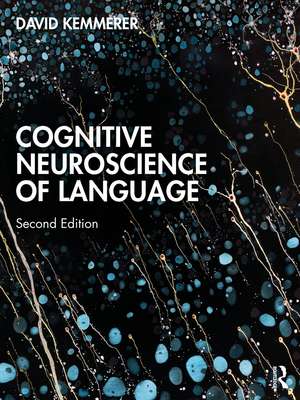Cognitive Neuroscience of Language
Autor David Kemmereren Limba Engleză Paperback – 30 mai 2022
This edition has been thoroughly updated throughout, and now includes a dedicated chapter on the neural substrates of bilingualism. Chapters have been revised to reflect the most salient developments in the field, and the book has undergone a thoughtful restructure to mirror course teaching.
While the study of language can be challenging, the text has been written accessibly and requires no previous knowledge of either neuroscience or linguistics and includes definitions of technical terms and explanations of important principles from both disciplines along the way. Accompanied by online resources for students and instructors, it is an essential companion for graduate or upper-level undergraduate students.
Preț: 580.02 lei
Preț vechi: 630.45 lei
-8% Nou
111.08€ • 113.35$ • 93.45£
Carte disponibilă
Livrare economică 05-19 februarie
Livrare express 21-25 ianuarie pentru 89.77 lei
Specificații
ISBN-10: 113831840X
Pagini: 702
Ilustrații: 55 Tables, black and white; 11 Line drawings, color; 504 Halftones, color; 515 Illustrations, color
Dimensiuni: 210 x 280 x 36 mm
Greutate: 2.12 kg
Ediția:2 ed
Editura: Taylor & Francis
Colecția Routledge
Locul publicării:Oxford, United Kingdom
Public țintă
Postgraduate and UndergraduateCuprins
Recenzii
Sheila Blumstein, Brown University, USA
"A thorough and timely update of the definitive text on the cognitive neuroscience of language."
Greg Hickok, University of California, Irvine, USA
"Cognitive Neuroscience of Language is an essential read for anyone wanting to gain a thorough and up-to-date understanding of the field. It synthesizes a very large body of work in a cohesive and engaging manner, striking a perfect balance between breadth of coverage and detail, all while highlighting debated topics and placing results within their broader context."
Narly Golestani, University of Geneva, Switzerland
Descriere
Cognitive Neuroscience of Language provides an up-to-date, wide-ranging, and pedagogically practical survey of the most important developments in this exciting field. It guides students through all of the major areas of investigation, beginning with the fundamental aspects of brain structure and function and then following with key topics such as classic and progressive aphasia syndromes; speech perception and production; the meanings of object nouns, action verbs, and abstract words; the formulation and comprehension of complex expressions, including grammatically inflected words, complete sentences, and entire stories; and several other domains of neurolinguistic research, including reading and writing, sign language, and the bilingual brain. Drawing heavily on prominent theoretical models, the core chapters illustrate how such frameworks are supported, and sometimes challenged, by experiments employing diverse brain mapping techniques.
This edition has been thoroughly updated throughout, and now includes a dedicated chapter on the neural substrates of bilingualism. Chapters have been revised to reflect the most salient developments in the field, and the book has undergone a thoughtful restructure to mirror course teaching. While the study of language can be challenging, the text has been written accessibly and requires no previous knowledge of either neuroscience or linguistics and includes definitions of technical terms and explanations of important principles from both disciplines along the way.
Accompanied by online resources for students and instructors, it is an essential companion for graduate or upper-level undergraduate students.
